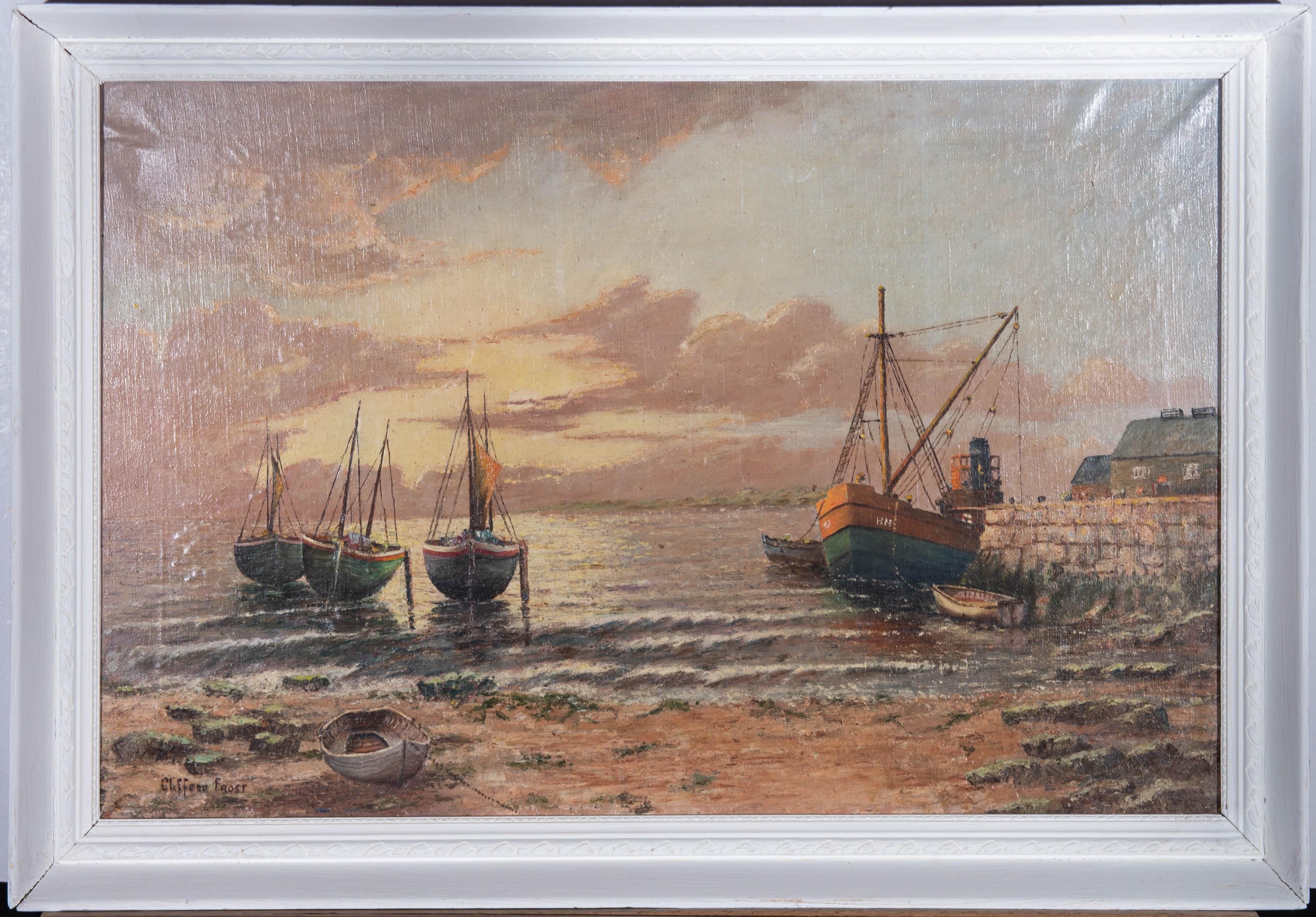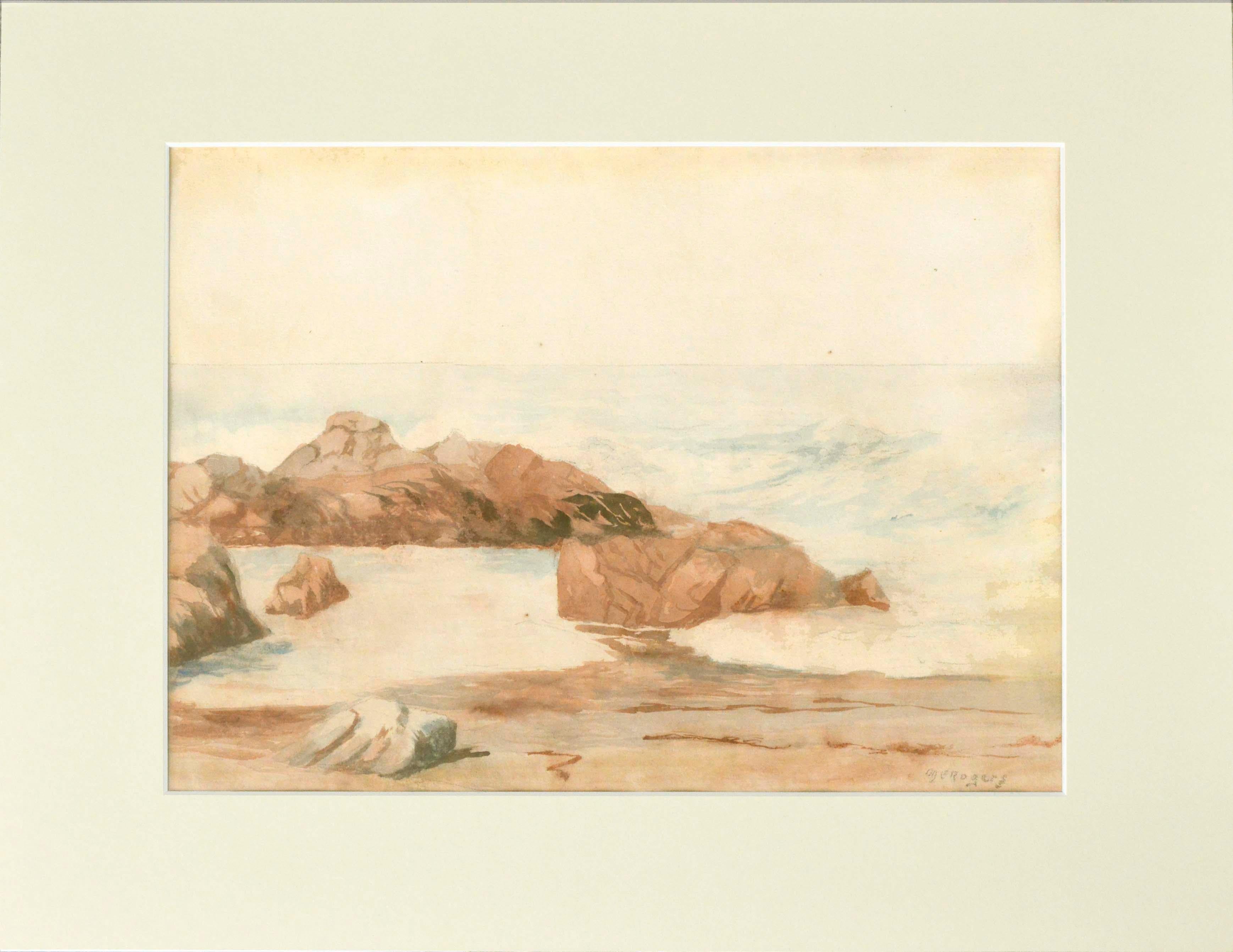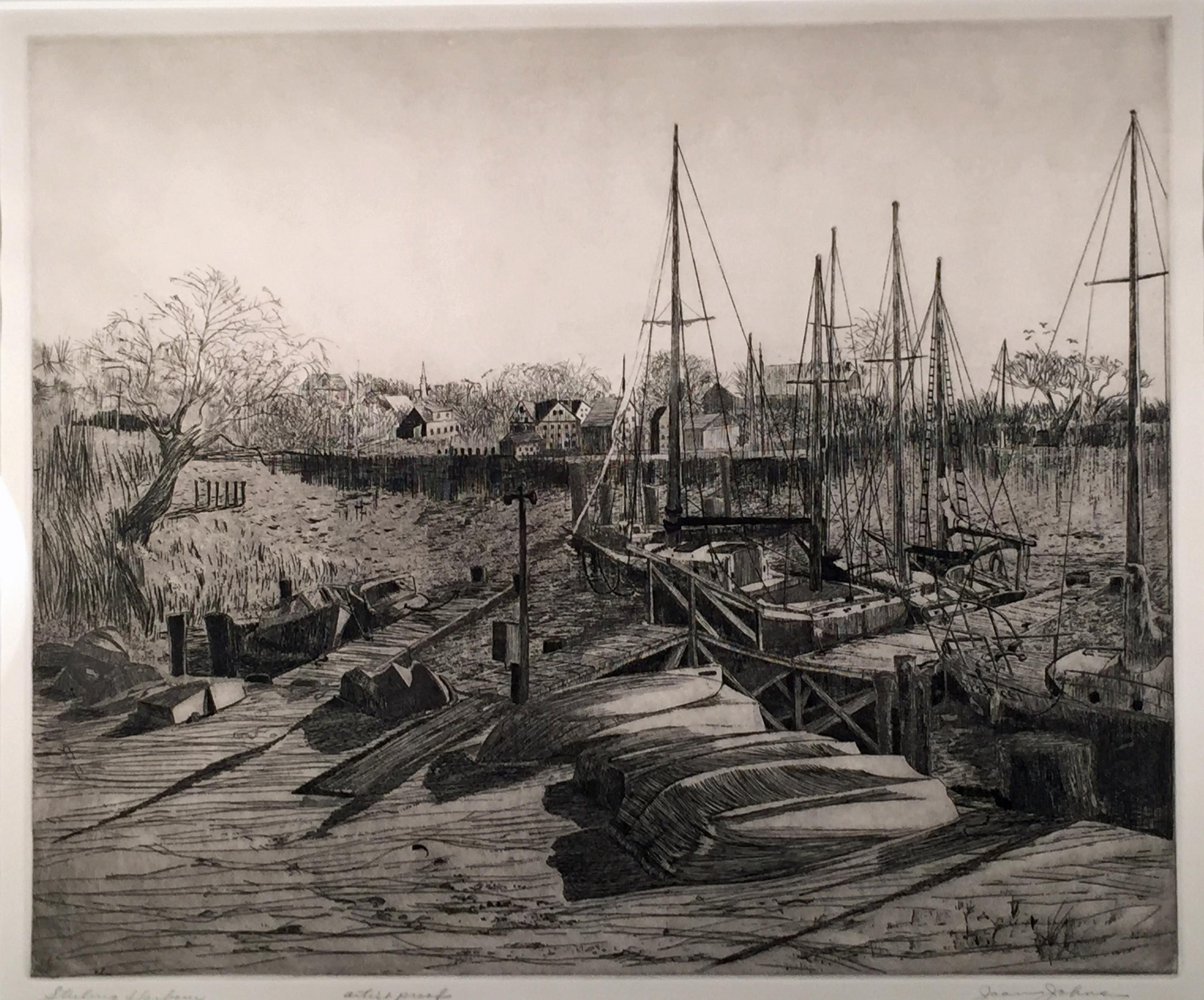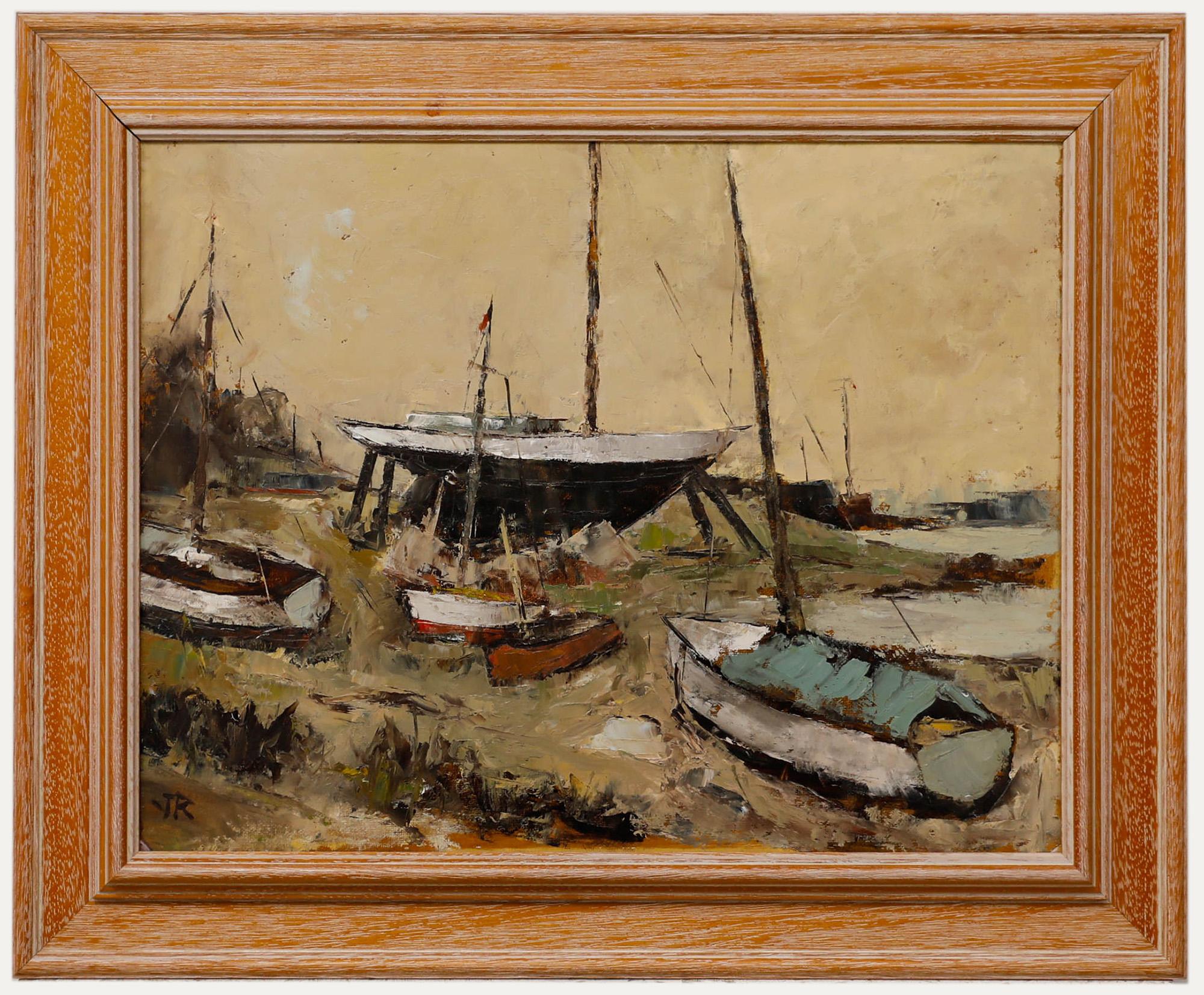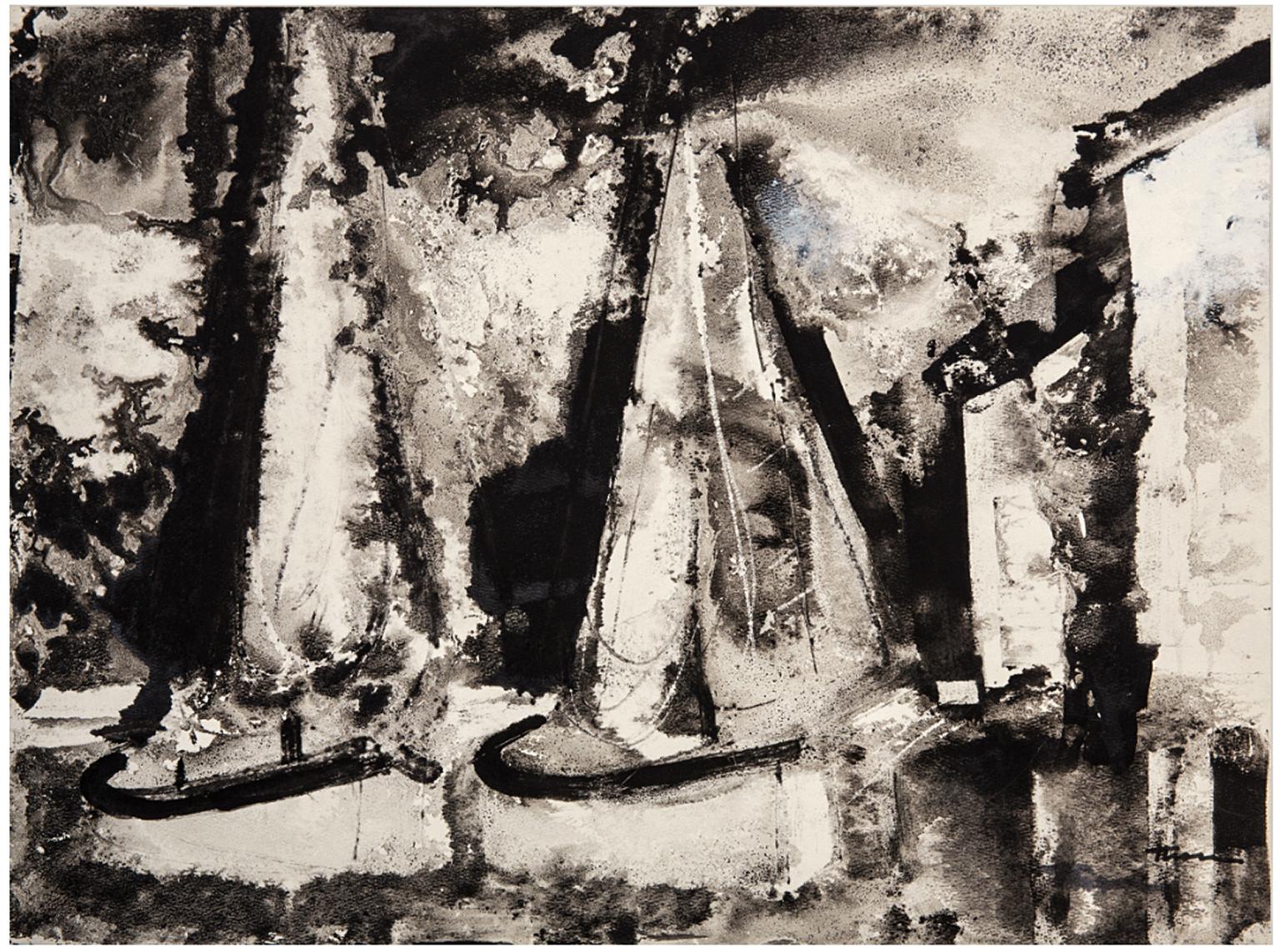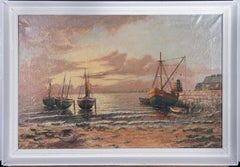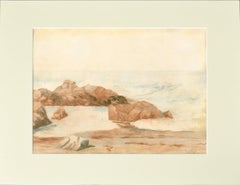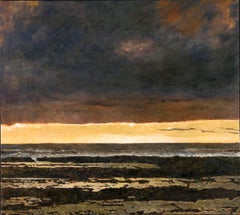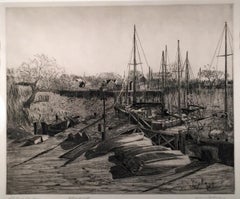Want more images or videos?
Request additional images or videos from the seller
1 of 8
Julian Edwin LeviLow Tide1943
1943
$600
£455.71
€526.50
CA$840.92
A$941.15
CHF 491.21
MX$11,477.17
NOK 6,286.79
SEK 5,951.25
DKK 3,929.21
Shipping
Retrieving quote...The 1stDibs Promise:
Authenticity Guarantee,
Money-Back Guarantee,
24-Hour Cancellation
About the Item
This artwork titled "Low Tide" 1943 is an original lithograph by New York artist Julian Edwin Levi, 1900-1982. It is hand signed in pencil by the artist. From the edition of 250, published by Associated American Artists, New York. The image size is 8.40 x 11 inches, sheet size is 10.25 x 13.5 inches. It is in very good condition.
About the artist:
Born in New York, Julian Levi spent his early years in Philadelphia. He began his art studies art at the Pennsylvania Academy of the Fine Arts under Arthur B. Carles, Daniel Garber, and Henry McCarter. On graduation, Levi was awarded a scholarship which he used to travel to Italy and Paris. During his stay in Europe, which lasted five years, from 1920 to 1925, Levi was influenced by Cubism. He was especially drawn to the art of Juan Gris, adopting the gentle color harmonies and precise linear treatments of forms found in Gris's works. In 1924, Levi participated in an important show of Philadelphia modern artists which included works by Charles Demuth, Hugh Breckinridge, Franklin Watkins, and his former teachers Carles and McCarter. A year later, he returned to Philadelphia, but found the art climate unreceptive to new trends. As Levi stated later, "modern artists were scandalous pariahs and much of our energy at that time was devoted to justifying our existence."
In 1932, Levi moved to New York, residing in Greenwich Village on Twelfth Street. He became the director of the art workshop at the New School for Social Research, and he also participated in projects organized by the Federal Art Project of the Works Progress Administration. During the years that followed, Levi contributed to many museum exhibitions, sending works to annuals at the Whitney Museum of American Art, the Art Institute of Chicago, the Cincinnati Art Museum, and others. His first one-man show was held at the Downtown Gallery in New York in 1940. Later in his career, he taught at the Art Students League and contributed frequently to the Magazine of Art. He was elected to the National Institute of Arts and Letters in 1959, and ten years later, he became vice-president of this organization. Known as a romantic painter, Levi created semi-abstract images of nature which feature subtle, delicate colors and decorative yet disciplined arrangements. He maintained a preference for figurative subject matter even in an era in which non-objective painting dominated the art world.
Levi's work is included in many important private and public collections including the Museum of Modern Art, New York; the Metropolitan Museum of Art, New York; the Albright-Knox Art Gallery, Buffalo; the Art Institute of Chicago; the New Britain Museum of American Art; the Newark Museum; the Sheldon Memorial Art Gallery, University of Nebraska, Lincoln; the Walker Art Center, Minneapolis, and many others.
- Creator:Julian Edwin Levi (1900 - 1982)
- Creation Year:1943
- Dimensions:Height: 10.25 in (26.04 cm)Width: 13.5 in (34.29 cm)Depth: 0.01 in (0.26 mm)
- Medium:
- Movement & Style:
- Period:
- Condition:
- Gallery Location:San Francisco, CA
- Reference Number:Seller: lev/low/tid/011stDibs: LU66635759041
About the Seller
5.0
Platinum Seller
Premium sellers with a 4.7+ rating and 24-hour response times
Established in 1999
1stDibs seller since 2017
809 sales on 1stDibs
Typical response time: 1 hour
- ShippingRetrieving quote...Shipping from: San Francisco, CA
- Return Policy
Authenticity Guarantee
In the unlikely event there’s an issue with an item’s authenticity, contact us within 1 year for a full refund. DetailsMoney-Back Guarantee
If your item is not as described, is damaged in transit, or does not arrive, contact us within 7 days for a full refund. Details24-Hour Cancellation
You have a 24-hour grace period in which to reconsider your purchase, with no questions asked.Vetted Professional Sellers
Our world-class sellers must adhere to strict standards for service and quality, maintaining the integrity of our listings.Price-Match Guarantee
If you find that a seller listed the same item for a lower price elsewhere, we’ll match it.Trusted Global Delivery
Our best-in-class carrier network provides specialized shipping options worldwide, including custom delivery.More From This Seller
View AllUntitled
By Ralph Ledesma
Located in San Francisco, CA
Artist: Ralph Ledesma – American (1910-1993)
Title: Untitled
Year: circa 1960
Medium: Watercolor
Sight size: 14.5 x 21.5 inches.
Framed size: 21.75 x 28.75 inches
Signature: Signed lower left
Condition: Very good
Frame: Framed in original frame. Frame in fair-good condition
This evocative watercolor is by California watercolor artist...
Category
Mid-20th Century American Realist Landscape Drawings and Watercolors
Materials
Paper, Watercolor
East Cove
By Virgil Trasher
Located in San Francisco, CA
This artwork titled "East Cove" 1987 in an original color serigraph by American artist Virgil Trasher b.1943. It is hand signed, inscribed A.P and titl...
Category
Late 20th Century American Modern Landscape Prints
Materials
Screen
Untitled (Coastal Scene)
Located in San Francisco, CA
This artwork "Untitled (Coastal Scene)" c.1990, is a watercolor on paper by noted Canadian/Japanese artist Suezan Aikins, b.1952. It is signed at the lower right corner by the artist. The artwork (image) size is 10 x 28 inches, framed size is 17.25 x 35.25 inches. Custom framed in a silver metal frame, with double off white matting. It is in excellent condition, the frame have some minor rubs and scratches.
About the artist:
Born in Montreal in 1952, Suezan was influenced early in her life by the works of modern Japanese woodblock printmakers which hung throughout her parents’ home. She attended the Fine Arts programme at Mount Allison University in Sackville, New Brunswick (1969 - 1971), The Ontario College of Art (1971-73), L’ ecole du Musee des Beaux Arts (1974), Nova Scotia College of Art and Design -BFA (1975) as well as a very intensive year of study with Toshi Yoshida in Tokyo (1984-85).
She has exhibited extensively in both public and private galleries throughout North America and Japan. Recent exhibitions include solo shows in Tokyo, Osaka, Okinawa, and Boston with group exhibitions at the Wenniger Gallery, Boston, Royal Canadian Academy in Toronto and the Canadian Museum of Nature in Ottawa.
Her paintings and woodblock prints are found in many collections such as The Canada Council Art Bank, The Nickle Art Museum, The Art Gallery of Nova Scotia, The Royal Bank of Canada, Prince Takamanonamiya Norihito, the Embassy of Canada in Tokyo, The Thomas Moore Institute as well as private collections.
Suezan Aikins was awarded the Elizabeth Greenshields Foundation grant in 1983, Nova Scotia Department of Culture - Development Grants in 1980, 1987 and 1988. She was elected to the Royal Canadian Academy of Art in 1990 and received the Canadian Progress Club- Women of Excellence Award for Culture in 1993. Her work has been featured in a number of television documentaries as well as many Canadian magazines.
STUDIES:
Yoshida Woodblock Print Studio Tokyo, 84-85
Nova Scotia College of Art & Design, Halifax, 74-75 BFA
Ecole du Musee des Beaux Arts, Montreal, 74
Ontario College of Art, Toronto, 71-73
Mt. Allison University, 69-72
SELECTED SOLO SHOWS:
25 Year Retrospective of Woodblock Prints traveled to three Public Galleries in Germany: Dornum Castle; Tollhousverein, Leer; Rastede Palace, Oldenberg 2000-2001 color catalog and reviews.
Private Exhibitions, Falmouth, Mass., July 1996; Montreal, November 1996; Gibson Island, Md., April 1999.
Gold Paintings and Woodblock Retrospective, travelling: Kabutoya Gallery, Tokyo; Genkan Gallery, Tokyo American Club; Blue Nile Gallery, Osaka; Kanda's Gallery BOQ, Okinawa; May 1994 (color catalogue)
Edo Gallery, Boston, November 1992, Private Exhibitions, Chatham, Mass, July 1992, Toronto, Oct. 1991
New Paintings and Woodblocks Kabutoya Gallery, Tokyo, May 1991, and also in 1987.
Japanese Garden and Pavilion Foundation, Montreal, September 1990, Ownens Art Gallery, Mount Allison University 1988
Zwickers Gallery, Halifax, NS, 1979; Gallery 78; Fredericton, November, 1983; Robertson Galleries, Ottawa, November, 1982
SELECTED GROUP SHOWS:
"A New Leaf" 30 foot instalation of mixed media/ goldleaf reliefs, Artsplace, Annapolis Royal, N.S., 2000 color catalog
"Far and Wide" Juried Bienials, Art Gallery of Nova Scotia; 1996 to '99, travelling, catalogs
"Moku Hanga Travelling Exhibition: Contemporary Japanese...
Category
Late 20th Century Realist Figurative Drawings and Watercolors
Materials
Watercolor
Atlantic City
By David Rosenthal
Located in San Francisco, CA
Artist: David Rosenthal (American 1876-1949)
Title: Atlantic City
Year: c.1930
Medium: Color Etching
Image (Plate mark) size: 9 x 13 inches
Sheet s...
Category
Early 20th Century American Impressionist Figurative Prints
Materials
Etching
Dust Time, large lithograph
By John Maxon
Located in San Francisco, CA
Artist: John Maxon (American, born 1947)
Title: Dust Time
Year: 1993
Medium: Color lithograph
Edition: Numbered 146/210
Paper: Arches
Image size: 26.5 x 39.75 inches
Paper size: 31.5 x 44 inches
Signature: Hand signed in pencil by the artist
Condition: Excellent, has never been framed
About the artist.
Coming from a very western tradition in Wyoming, John Maxon developed an expansive view of nature . Moving eventually to the San Francisco Bay area, John's delight in the effects of light and color led him to the decision to become an artist at the young age of 15. His natural ability was encouraged, and at 16 he began figurative art classes with Howard Brodie, the artist well known for his WWII correspondence, drawings and the Watergate trial drawings.
Education
San Francisco Art Institute
B.A., Painting, San Jose State University
M.F.A., Painting, University of California, Davis
Stanford University, Palo Alto, California
Cabrillo College, Aptos, California
Selected Solo Exhibitions
2018
Gallery Panza Verde – Antigua Guatemala, Guatemala
2015
Desert Art Collection - Palm Desert California
2015
Galeria Antigua – Antigua, Guatemala
2014
Galeria Panza Verde – Antigua, Guatemala
2008
Linda Durnell Gallery – Los Gatos, California
2006
Linda Durnell Gallery – Los Gatos, California
2005
Robert Allen Fine Art Gallery – Sausalito, California
2004
Ellis West Gallery – Durango, Colorado
2002
Ellis West Gallery – Durango, Colorado
2001
Robert Allen Fine Art Gallery – Sausalito, California
1997
Stanford University Faculty Club – Stanford, California
Selected Group Exhibitions
2018
Chemers Art Gallery – Los Angeles, California
2009, 2010, 2016, 2017 & 2018
Robert Allen Fine Art – Sausalito, California
2017 Christopher Hill Gallery - St Helena, California
2013 / 19
Gallery North - Carmel, California
2015
Desert Art Collection - Palm Desert, California
2014
Paul Scott Gallery - Bend, Oregon
2014
Christopher Hill Gallery Healdsberg, California
2013
Firehouse Art Center - Pleasanton, Ca. 2013
2011 - 2013
Robert Allen Fine Art – Sausalito, California
2010 - 2012
Susan Street Gallery – Solano Beach, California
2010 (Awarded 1st place) and 2012
“Contemporary Landscape Painters of California” – Awarded 1st Place
2011 - 2012
Salisbury Fine Art – Avila Beach, California
2010
Bryant Street Gallery – Palo Alto, California
2009
Museum Art and History – Santa Cruz, California
2008
Cabrillo College – Aptos, California
2006
Christopher Hill Gallery – St. Helena, California
2005
Fort Lewis College – Durango, Colorado
2001
St. Supery Winery & Fine Art Gallery, Napa California
2001
Napa Valley Wine Auction – St. Helena, California
1997
West Coast Painting and Sculpture – Ocean Side, California
1997
Wolk Gallery – St. Helena, California
Selected Museum Collections
Interior Museum, Department of the Interior, Washington D. C.
Santa Cruz County Art Museum – Santa Cruz, California
University of California – Berkeley, California
University of California – Davis, California
Napa Valley Art...
Category
Late 20th Century American Impressionist Landscape Prints
Materials
Lithograph
Un Longue Apres Midi
Located in San Francisco, CA
This artwork titled "Un Longue Apres Midi" 1984 is an original color etching with aquatint on Arches paper by French artist Jean Solombre, 1948-2005. It ...
Category
Late 20th Century Surrealist Landscape Prints
Materials
Etching, Aquatint
You May Also Like
Clifford Frost - 20th Century Oil, Low Tide
Located in Corsham, GB
A pleasant seascape in oil by Clifford Frost, depicting a sunset beach scene with boats. Signed to the lower left-hand corner. The artist name and title are inscribed on the reverse....
Category
21st Century and Contemporary Figurative Paintings
Materials
Oil
$361 Sale Price
20% Off
Low Tide - Mid Century Seascape
By Margaret Esther Rogers
Located in Soquel, CA
Beautiful mid century seascape of the waves spilling over the rocks into the tide pool by Margaret Esther Rogers (British/American, 1872-1961). Si...
Category
1940s American Impressionist Landscape Paintings
Materials
Canvas, Oil, Cardboard
Low Tide
By Kristen Garneau
Located in Mill Valley, CA
Although the paintings of Kristen Garneau begin with actual experiences in nature, she is influenced as much by Abstract Expressionist masters as she is by the more traditional lands...
Category
21st Century and Contemporary Contemporary Landscape Paintings
Materials
Canvas, Oil
STERLING HARBOUR
Located in Portland, ME
Johns, Joan. STERLING HARBOUR. Etching, not dated, but probably 1950s-60s. titled, inscribed "Artist's Proof," and signed in pencil. Printed on heavy wove paper. 19 1/4 x 23 5/8 inch...
Category
1950s Landscape Prints
Materials
Etching
J. Richards - Framed Contemporary Oil, Low Tide
By J. Richardson
Located in Corsham, GB
This striking oil painting depicts a coastal landscape with sailboats beached at low tide. The composition skilfully balances the larger central boat under repair with smaller vessel...
Category
21st Century and Contemporary Figurative Paintings
Materials
Oil
Alongside
By William Thon
Located in Myrtle Beach, SC
William Thon, 'Alongside', watercolor, c. 1990. Signed, lower right; titled verso. A fine, expressionist work, on off-white watercolor paper; the image extending to the sheet edges, ...
Category
1950s American Modern Figurative Drawings and Watercolors
Materials
Watercolor
